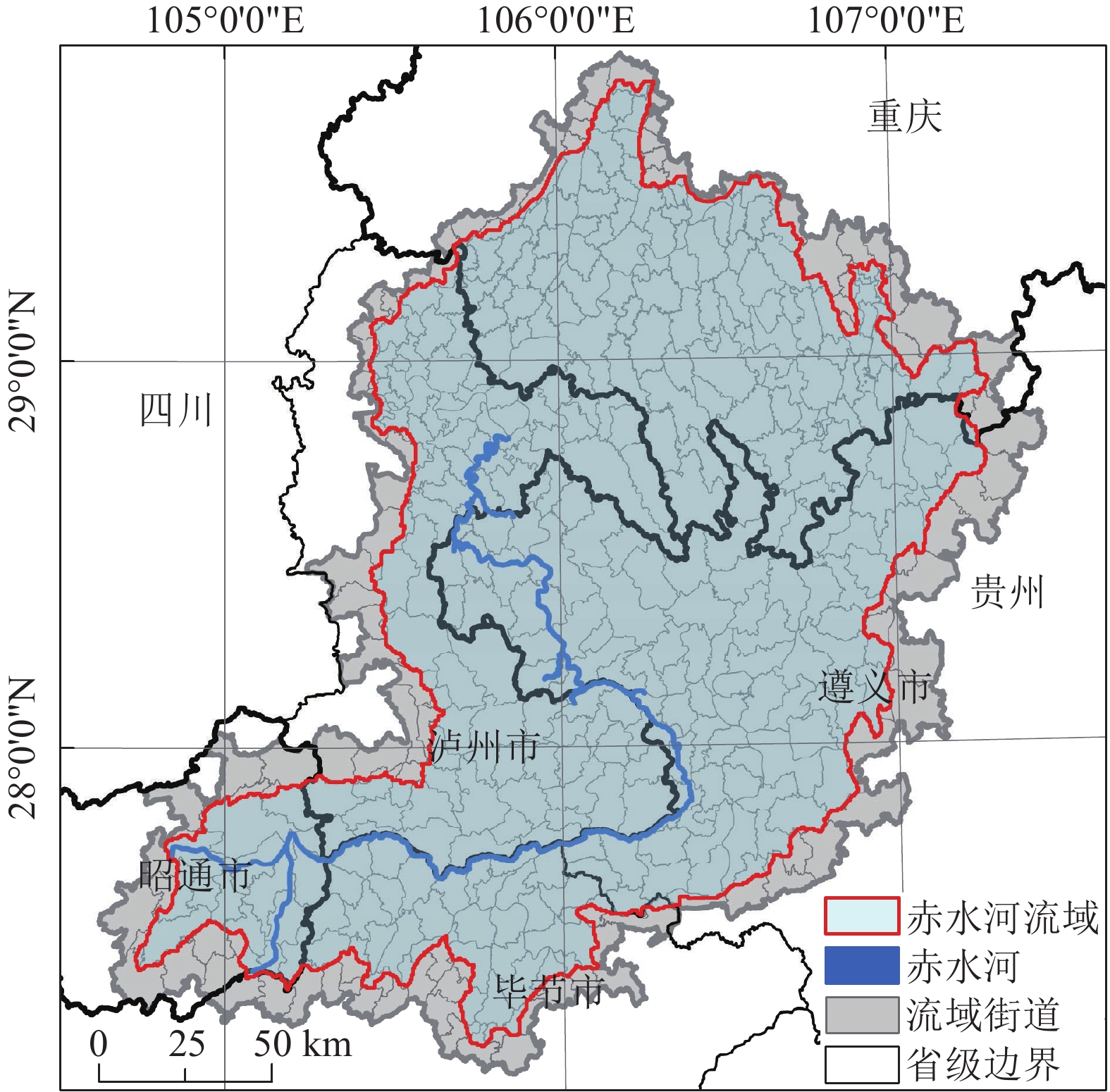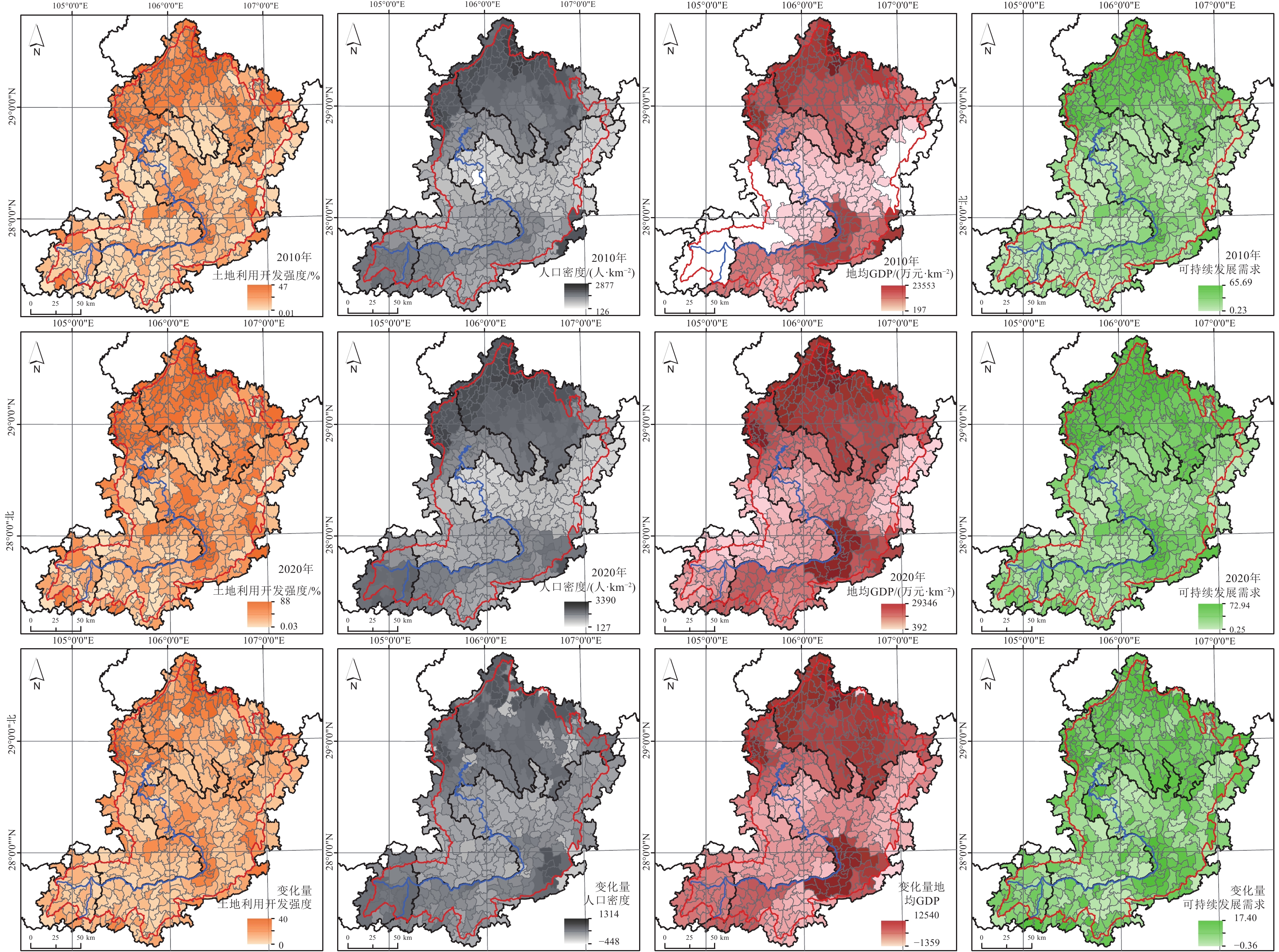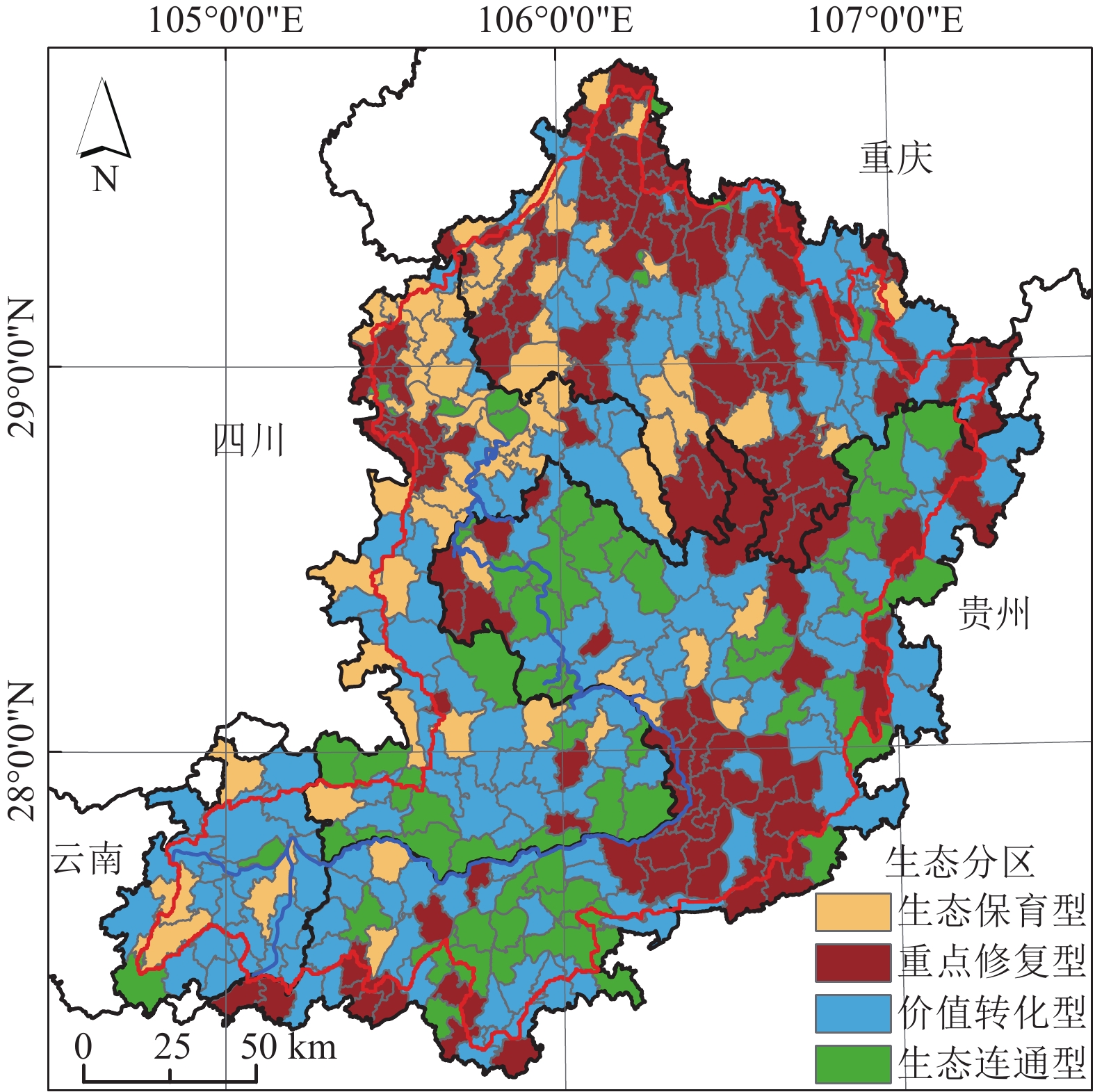Ecological zoning from the perspective of coupling ecosystem service supply and demand in the Chishui River Basin
-
摘要:
生态系统服务是连接自然生态系统和社会经济系统的关键桥梁,对经济社会发展和保障人类福祉具有重要意义。从生态系统服务供给与需求的关系出发,开展生态修复分区研究,是新时期因地制宜制定针对性生态保护修复策略和协调区域间发展的重要前提。以赤水河流域为研究区,以409个街道(镇)为评价单元,分析2010—2020年生态系统服务供需变化及二者耦合协调程度。其中,高阶耦合(n=61)、高阶失调(n=140)、低阶失调(n=63)和低阶耦合(n=145)的供给变化量(z-score标准化)分别为1.7 ± 2.1、−0.9 ± 2.2、5.9 ± 6.4和−0.1 ± 0.5,需求变化量(z-score标准化)分别为0.6 ± 1.1、2.1 ± 2.4、0.7 ± 2.4和−0.5 ± 0.4。结合各区供需变化量本文提出了生态保育型、重点修复型、生态连通型、价值转化型等赤水河流域差异化生态保护修复分区策略,为区域生态保护修复提供了科学依据。
Abstract:Ecological zoning from the perspective of coupling the supply and demand of the ecosystem services is instrumental in promoting the sustainable development of social−ecological system. In this study, the ecosystem services supply (ESS) and ecosystem services demand (ESD) the between 2010 and 2020 in Chishui River Basin were investigated. The coupling degrees were calculated based on the changes in ESS and ESD between 2010 and 2020. According to the results of coupling degree, the 409 study units (streets/towns) were divided into four categories. The averaged ESS changes for the high order of coupling degrees zonation, high order of uncoupling degree zonation, low order of uncoupling degree zonation and low order of uncoupling degree zonation are 1.7 ± 2.1, −0.9 ± 2.2, 5.9 ± 6.4 and −0.1 ± 0.5, respectively. The averaged ESD changes are 0.6 ± 1.1, 2.1 ± 2.4, 0.7 ± 2.4 and −0.5 ± 0.4, respectively. The 61 streets/towns with high order of coupling degrees represented for conversation−oriented zone in which should focus on conservation on the key and typical landscapes, improve the existing ecosystem network and highlight the regional social−ecological complex functions. The 140 streets/towns with high order of uncoupling degree represented for key restoration zone, in which focused on incorporating key areas for ecological restoration into regional development planning. The 63 streets/towns with low order of uncoupling degree represented for network−oriented zone, focusing at establishing ecological corridors and networks to improve the connectivity, so as to maintain important the continuous supply of ecosystem services in the region. The 145 streets/towns with low order of uncoupling degree represented for ecological livelihood−oriented zone focusing at alternative livelihood through ecological branding and products value gaining. The finding of the ecological zoning scheme of the Chishui River Basin reflects the differences in the spatial allocation of regional environmental resources and can provide technical guidance on spatial planning for ecological conservation and restoration.
-
-
表 1 本次研究主要数据及来源
Table 1 Main data and data source used in this study
数据类型 数据名称 分辨率 时段/年 来源 基础地理数据 行政边界数据 1∶10000 地球系统科学数据共享平台https://www.geodata.cn/data/ 数字高程模型DEM 30 m 地理空间数据云https://www.gscloud.cn/ 栅格数据 夜间灯光数据 500 m 2010和2020 https://doi.org/10.7910/DVN/YGIVCD 土地利用覆被数据 30 m 2010和2020 资源环境数据中心https://www.resdc.cn/DOI/DOI.aspx?DOIID=54 社会经济数据 人口 1 km 2010和2020 资源环境数据中心https://www.resdc.cn/data.aspx?DATAID=269 GDP 1 km 2010和2020 资源环境数据中心https://www.resdc.cn/data.aspx?DATAID=269 统计年鉴 年鉴 2010和2020 重庆、云南昭通、四川泸州、贵州遵义、贵州毕节政府网站
https://www.cq.gov.cn/zwgk/zfxxgkzl/fdzdgknr/tjxx/tjnj/
http://www.zt.gov.cn/channels/3122.html
http://8.137.105.48:10020/yearBookList.html
https://www.bijie.gov.cn/bm/bjstjj/zwgk/tjsj/tjnj/
https://tjj.zunyi.gov.cn/tjnj/表 2 赤水河流域供需变化分区统计
Table 2 Statistics on the number of ecological zones in the Chishui River Basin
组合类型 组合定义 单元数/个 供给变化量
(z-score标准化)需求变化量
(z-score标准化)分区方案 高阶耦合 耦合−供需综合指数高 61 1.7 ± 2.1 0.6 ± 1.1 生态保育型 高阶失调 非耦合−供需综合指数高 140 −0.9 ± 2.2 2.1 ± 2.4 重点修复型 低阶失调 非耦合−供需综合指数低 63 5.9 ±6.4 0.7 ± 2.4 生态连通型 低阶耦合 耦合−供需综合指数低 145 −0.1 ± 0.5 −0.5 ± 0.4 价值转化型 -
Cai H, He Z W, An Y L, et al. 2014. Correlation intensity of vegetation coverage and topographic factors in Chishui Watershed based on RS and GIS[J]. Earth and Environment, 42(4): 518−524(in Chinese with English abstract).
Chen Z, Yu B, Yang C, et al. 2021. An extended time series (2000–2018) of global NPP−VIIRS−like nighttime light data from a cross−sensor calibration[J]. Earth System Science Data, 13(3): 889−906(in Chinese with English abstract). doi: 10.5194/essd-13-889-2021
Dao R N, Bao Y H. 2019. Dynamic of the drought based on the ecological partition in Inner Mongolia during 1980−2015[J]. Research of Soil and Water Conservation, 26(3): 159−165(in Chinese with English abstract).
Dan Y Z, Peng J, Zhang Z M, et al. 2020. Territorially ecological restoration zoning based on the framework of degradation pressure, supply state and restoration potential: A case study in the Pearl River Delta region [J]. Acta Ecologica Sinica, 40(23): 8451−8460(in Chinese with English abstract).
Fu B J. 2021. Several key points in territorial ecological restoration[J]. Bulletin of Chinese Academy of Sciences, 36(1): 64−69(in Chinese with English abstract).
Guo C H, Zhang M S, Wang Y, et al. 2023. Ecological restoration of China's territorial space in Yulin section of the Yellow River Basin through nature−based solutions[J]. Geological Bulletin of China, 42(10): 1745−1756 (in Chinese with English abstract).
Li J Z, Wang M, Feng W J, et al. 2022. The characteristics and driving factors of spatiotemporal changes in the ecosystem service value in Xiangxi, Hunan, China[J]. Remote Sensing for Natural Resources, 34(3): 207−217(in Chinese with English abstract).
Li X, Yu X, Wu K, et al. 2021. Land−use zoning management to protecting the regional key ecosystem services: A case study in the city belt along the Chaobai River, China[J]. Science of the Total Environment, 762: 143167.
Liu F, Liu H. 2023. Effectiveness and challenges of aquatic ecological restoration of Chishui River in upper Yangtze River[J]. Bulletin of Chinese Academy of Sciences, 38(12): 1883−1893(in Chinese with English abstract).
Liu Q, Li G, Zhang C, et al. 2019. Study on dynamic changes in ecosystem service values in Qinglong County based on coefficient correction[J]. Chinese Journal of Eco−Agriculture, 27(6): 971−980 (in Chinese with English abstract).
Liu X, Liu L, Peng Y. 2017. Ecological zoning for regional sustainable development using an integrated modeling approach in the Bohai Rim, China[J]. Ecological Modelling, 353: 158−166. doi: 10.1016/j.ecolmodel.2016.09.027
Lu H T, Stringer L C, Yan Y, et al. 2023. Mapping ecosystem service supply and demand: Historical changes and projections under SSP−RCP scenarios[J]. Acta Ecologica Sinica, 43(4): 1–17(in Chinese with English abstract).
Ma L, Liu H, Peng J, et al. 2017. A review of ecosystem services supply and demand[J]. Acta Geographica Sinica, 72(7): 1277−1289(in Chinese with English abstract).
Peng J, Yang Y, Xie P, et al. 2017. Zoning for the construction of green space ecological networks in Guangdong Province based on the supply and demand of ecosystem services[J]. Acta Ecologica Sinica, 37(13): 4562−4572(in Chinese with English abstract).
Peng J, Li B, Dong J Q. 2020a. Basic logic of territorial ecological restoration[J]. China Land Science, 34(5): 18−26(in Chinese with English abstract).
Peng J, Lyu D N, Dong J Q, et al. 2020b. Processes coupling and spatial integration: Characterizing ecological restoration of territorial space in view of landscape ecology[J]. Journal of Natural Resources, 35(1): 3−13(in Chinese with English abstract). doi: 10.31497/zrzyxb.20200102
Villamagna A M, Angermeier P L, Bennett E M. 2013. Capacity, pressure, demand, and flow: A Conceptual Framework for Analyzing Ecosystem Service Provision and Delivery [J]. Ecological Complexity, 15(9): 114–21.
Wang J, Ying L X, Zhong L N. 2020. Thinking for the transformation of land consolidation and ecological restoration in the new era[J]. Journal of Natural Resources, 35: 26−36 (in Chinese with English abstract). doi: 10.31497/zrzyxb.20200104
Wang J, Zhong L N. 2019. Application of ecosystem service theory for ecological protection and restoration of mountain−river−forest− field−lake−grassland[J]. Acta Ecologica Sinica, 39(23): 8702−8708(in Chinese with English abstract).
Wang J, Peng J, Fu B J. 2023. Integrated ecological protection and restoration in the Guangdong−Hong Kong−Macao Greater Bay area: thoughts and suggestions[J]. Bulletin of Chinese Academy of Sciences, 38(2): 288−293(in Chinese with English abstract).
Wang S, Zhang Q, Wang Z F, et al. 2022. GIS−based ecological risk assessment and ecological zoning in the Three Gorges Reservoir area[J]. Acta Ecologica Sinica, 42(11): 4654−4664 (in Chinese with English abstract).
Wang Y, Zhang M, Chen H J, et al. 2023. Ecological protection– restoration practice of mountains rivers forests farmlands lakes grasslands sands in the Jialu River Basin[J]. Northwestern Geology, 56(3): 121−128 (in Chinese with English abstract) .
Wang Z Y, Huang C L, Li L, et al. 2022. Ecological zoning planning and dynamic evaluation coupled with Invest−HFI−Plus model: A case study in Bortala Mongolian autonomous prefecture[J]. Acta Ecologica Sinica, 42(14): 5789−5798 (in Chinese with English abstract).
Xie G D, Zhang C X, Zhang L M, et al. 2015. Improvement of the evaluation method for ecosystem service value based on per unit area[J]. Journal of Natural Resources, 30(8): 1243−1254(in Chinese with English abstract).
Xie L X, Bai Y P, Che L, et al. 2022. Construction of ecological zone based on value−risk ecological function area in the Upper Yellow River [J]. Journal of Natural Resources, 36(1): 196−207(in Chinese with English abstract).
Xin R, Skov−petersen H, Zeng J, et al. 2021. Identifying key areas of imbalanced supply and demand of ecosystem services at the urban agglomeration scale: A case study of the Fujian Delta in China[J]. Science of the Total Environment, 791: 148173. doi: 10.1016/j.scitotenv.2021.148173
Xu Q, Yang R, Zhuang D, et al. 2021. Spatial gradient differences of ecosystem services supply and demand in the Pearl River Delta region[J]. Journal of Cleaner Production, 279: 123849. doi: 10.1016/j.jclepro.2020.123849
Xu Z, Peng J, Dong J, et al. 2022. Spatial correlation between the changes of ecosystem service supply and demand: An ecological zoning approach[J]. Landscape and Urban Planning, 217: 104258. doi: 10.1016/j.landurbplan.2021.104258
Yan Y, Zhu J Y, Wu G, et al. 2017. Review and prospective applications of demand, supply, and consumption of ecosystem services [J]. Acta Ecologica Sinica, 37(8): 2489−2496(in Chinese with English abstract).
Yang C, Zeng W, Yang X. 2020. Coupling coordination evaluation and sustainable development pattern of geo−ecological environment and urbanization in Chongqing municipality, China[J]. Sustainable Cities and Society, 61: 102271.
Yang Z W, Chen Y B, Wu Z F, et al. 2018. The coupling between construction land expansion and urban heat island expansion in Guangdong−Hong Kong−Macao Greater Bay [J]. Journal of Geo−information Science, 20(11): 1592−1603 (in Chinese with English abstract).
Yang Z, Chen Y, Qian Q, et al. 2019. The coupling relationship between construction land expansion and high−temperature area expansion in China’s three major urban agglomerations[J]. International Journal of Remote Sensing, 40(17): 6680−6699.
Yang S F, An Y L, Wang P B, et al. 2015. Study of ecological red−line zones in guizhou chishui river basin[J]. Resources and Environment in the Yangtze Basin, 24(8): 1405−11(in Chinese with English abstract).
Yue W Z, Hou L, Xia H X, et al. 2022. Territorially ecological restoration zoning and optimization strategy in Guyuan City of Ningxia, China: Based on the balance of ecosystem service supply and demand[J]. Chinese Journal of Applied Ecology, 33(1): 149−158(in Chinese with English abstract).
Zhao C C, Pan J H. 2022. Ecological safety pattern identification and optimization based on the ecological supply and demand in Gansu section of the Yellow River Basin[J]. Acta Ecologica Sinica, 42(17): 6973−6984(in Chinese with English abstract).
Zhao W W, Liu Y, Feng Q, et al. 2018. Ecosystem services for coupled human and environment systems[J]. Progress in Geography, 37(1): 139−151(in Chinese with English abstract). doi: 10.18306/dlkxjz.2018.01.015
Zhao Y, Wang N, Luo Y, et al. 2022. Quantification of ecosystem services supply−demand and the impact of demographic change on cultural services in Shenzhen, China[J]. Journal of Environmental Management, 304: 114280.
Zhang Y Y, Sun M Y, Yang R J, et al. 2022. Impact of land−use change on ecosystem service value in Southwest China[J]. Journal of Environmental Engineering Technology, 12(1): 207−214 (in Chinese with English abstract).
蔡宏, 何政伟, 安艳玲, 等. 2014. 基于RS和GIS的赤水河流域植被覆盖度与各地形因子的相关强度研究[J]. 地球与环境, 42(4): 518−524. 道日娜, 包玉海. 2019. 基于生态分区的1980—2015年内蒙古干旱动 态[J]. 水土保持研究, 26(3): 159−165. 丹宇卓, 彭建, 张子墨, 等. 2020. 基于“退化压力−供给状态−修复潜力”框架的国土空间生态修复分区——以珠江三角洲为例[J]. 生态学报, 40(23): 8451−8460. 傅伯杰. 2021. 国土空间生态修复亟待把握的几个要点[J]. 中国科学院院刊, 36(1): 64−69. 郭迟辉, 张茂省, 王尧, 等. 2023. 基于自然解决方案的黄河中游国土空间生态修复——以陕西榆林国土空间生态修复为例[J]. 地质通报, 42(10): 1745−1756. doi: 10.12097/j.issn.1671-2552.2023.10.011 李静芝, 王苗, 冯文静, 等. 2022. 湘西州地区生态系统服务价值时空特征及驱动分析[J]. 自然资源遥感, 34(3): 207−217. 刘飞, 刘焕章. 2023. 长江上游赤水河示范区水生态修复的成效与挑 战[J]. 中国科学院院刊, 38(12): 1883−1893. 刘倩, 李葛, 张超, 等. 2019. 基于系数修正的青龙县生态系统服务价值动态变化研究[J]. 中国生态农业学报(中英文), 27(6): 971−980. 卢慧婷, Stringer L C, 严岩, 等. 2023. 西南地区生态系统服务供需历史变化与SSP-RCP情景预测[J]. 生态学报, 43(4): 1–17. 马琳, 刘浩, 彭建, 等. 2017. 生态系统服务供给和需求研究进展[J]. 地理学报, 72(7): 1277−1289. doi: 10.11821/dlxb201707012 彭建, 杨旸, 谢盼, 等. 2017. 基于生态系统服务供需的广东省绿地生态网络建设分区[J]. 生态学报, 37(13): 4562−4572. 彭建, 李冰, 董建权, 等. 2020a. 论国土空间生态修复基本逻辑[J]. 中国土地科学, 34 (5): 18–26. 彭建, 吕丹娜, 董建权, 等. 2020b. 过程耦合与空间集成: 国土空间生态修复的景观生态学认知[J]. 自然资源学报, 35: 3−13. 王军, 应凌霄, 钟莉娜. 2020. 新时代国土整治与生态修复转型思考[J]. 自然资源学报, 35: 26−36. 王军, 钟莉娜. 2019. 生态系统服务理论与山水林田湖草生态保护修复的应用[J]. 生态学报, 39(23): 8702−8708. 王军, 彭建, 傅伯杰. 2023. 关于粤港澳大湾区一体化生态保护修复的思考与建议[J]. 中国科学院院刊, 38(2): 288−293. 王舒, 张骞, 王子芳, 等. 2022. 基于GIS的三峡库区生态风险评估及生态分区构建[J]. 生态学报, 42(11): 4654−4664. 王尧, 张茂省, 陈华军, 等. 2023. 佳芦河流域山水林田湖草沙生态保护修复实践研究[J]. 西北地质, 56(3): 121−128. doi: 10.12401/j.nwg.2023095 王子尧, 黄楚梨, 李倞, 等. 2022. 耦合InVEST-HFI-PLUS模型的生态分区规划与动态评估——以博尔塔拉蒙古自治州为例[J]. 生态学报, 42(14): 5789-5798. 谢高地, 张彩霞, 张雷明, 等. 2015. 基于单位面积价值当量因子的生态系统服务价值化方法改进[J]. 自然资源学报, 30(8): 1243−1254. 谢丽霞, 白永平, 车磊, 等. 2021. 基于价值—风险的黄河上游生态功能区生态分区建设[J]. 自然资源学报, 36(1): 196−207. 严岩, 朱捷缘, 吴钢, 等. 2017. 生态系统服务需求、供给和消费研究进展[J]. 生态学报, 37(8): 2489−2496. 杨智威, 陈颖彪, 吴志峰, 等. 2018. 粤港澳大湾区建设用地扩张与城市热岛扩张耦合态势研究[J]. 地球信息科学学报, 20(11): 1592−1603. 杨世凡, 安裕伦, 王培彬, 等. 2015. 贵州赤水河流域生态红线区划分研究[J]. 长江流域资源与环境, 24(8): 1405−1411. 岳文泽, 侯丽, 夏皓轩, 等. 2022. 基于生态系统服务供需平衡的宁夏固原生态修复分区与优化策略[J]. 应用生态学报, 33(1): 149−158. 赵诚诚, 潘竟虎. 2022. 基于供需视角的黄河流域甘肃段生态安全格局识别与优化[J]. 生态学报, 42(17): 6973−6984. 赵文武, 刘月, 冯强, 等. 2018. 人地系统耦合框架下的生态系统服务[J]. 地理科学进展, 37(1): 139−151. 张钰莹, 孙美莹, 杨荣金, 等. 2022. 西南地区土地利用变化对生态系统服务价值的影响[J]. 环境工程技术学报, 12(1): 207−214. -
期刊类型引用(2)
1. 杨旭明,文鹏帆,张春亢,张显云,康雅敬. 基于GTWR-LightGBM模型的京津冀地区近地面SO2浓度估算. 环境科学与技术. 2024(10): 204-215 .  百度学术
百度学术
2. 叶烨,叶晗迪,鲍杰利. 基于改进Adaboost算法的分布式光伏发电孤岛检测方法. 机电技术. 2024(05): 14-17+33 .  百度学术
百度学术
其他类型引用(1)




 下载:
下载:



